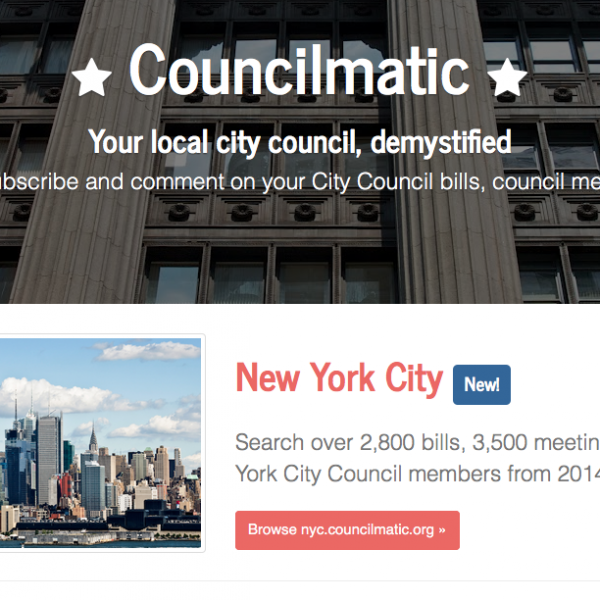OPEN GOV’T PLATFORM FOR CITIES NOW IN NYC
- JESSICA MCKENZIE
- November 23, 2015
- 7:05 am
An open government platform launches in the city, with new features designed to increase civic engagement and participation in City Council meetings.
In 2011, Philadelphia was roiling over proposed changes to a retirement program for city employees that had cost the city $258 million in the decade after it was implemented in 1999. Mayor Michael Nutter wanted to cut the program all together, whereas Council members (some of whom benefited from the plan) wanted to merely scale it back. Mjumbe Poe, then a Code for America fellow, recalls that “with the way it was being covered, I wasn’t really getting what was going on.” So he started digging for primary source material, trying to get at the root of the issue. That’s where he ran into trouble.
“My options were limited,” Poe tells Civicist. “Generally pretty poor.” The city’s legislative portal, Legistar, was even less user-friendly then than it is now.
In addition to looking for background information, Poe wanted to be notified when things he was interested in came up in City Council meetings. That February, at one of the weekly hacknights he organized as a Code for America fellow, Poe led an introduction to scraping and, as an example, scraped the council minutes and agenda from Legistar. At another hacknight later that month, a team took his idea and built the first subscription service, an RSS feed that would send items with your search terms to an RSS reader. It was the earliest iteration of Councilmatic, an open government tool that was implemented in Chicago in 2013 and New York City just this year.
NYC Councilmatic, which launched earlier this fall at the Code for America Summit, is a project by the nonprofit Participatory Politics Foundation (PPF) in partnership with the civic technology company DataMade, and supported by Rita Allen Foundation. Like the original Councilmatic in Philadelphia, people can use NYC Councilmatic to find and track laws, resolutions, and other City Council activities on a more user-friendly platform than the official Legistar portal. In addition, David Moore, the executive director of PPF, is adding or boosting features meant to increase public participation, for example: highlighting legislation on the home page to draw visitors in; reaching out to local community groups to invite them to use the comment forum; and partnering with a text-messaging service to make the platform more accessible.
Improving on a city’s official legislative portal is a relatively easy task, but NYC Councilmatic aspires to a higher bar: to “demystify” the New York City Council.
“Pure legislative transparency alone isn’t going to give a site as much impact as we want it to have,” Moore tells Civicist. (Full disclosure: David Moore is a Civic Hall member.) “Open data alone isn’t enough.”
But, Moore adds, “if you provide official information in a shareable format with participation tools, you can see communities organically coming together to take action.” To illustrate his point, Moore points to a 2010 techPresident article by Civic Hall’s Micah Sifry about how the unemployed were coming together on platforms like OpenCongress—an open government platform at the federal level that PPF developed and operated until it was acquired by the Sunlight Foundation in 2013—in “de facto, organizing networks and self-help communities.” In the same piece, Sifry noted that three bills about unemployment benefits had garnered more than 130,000 comments on OpenCongress.
“It’s been proven that on sites like OpenCongress and OpenGovernment.org [like OpenCongress but for states], people come together around their interests, to share information,” says Moore. “This is the model that we’ve been working to bring to city governments for the past four years and with Councilmatic it’s finally happening.”
Councilmatic started as an off-the-cuff project during a hacknight, so the blocks to make it easily replicable weren’t in place.
“I didn’t put a lot of effort into making it easy to deploy in other places,” Mjumbe Poe tells Civicist. “It was always a desire, but it was a side project from the beginning.”
“It took longer than expected,” says Derek Eder, of repurposing the platform in Chicago. Derek Eder co-founded the civic hacking group Open City, which got Chicago Councilmatic up and running, and founded DataMade, which is a partner on NYC Councilmatic.
In addition to not being familiar with the code base, Eder points out that significant differences in the way Chicago and Philadelphia’s city councils work necessitated extra features. Eder says the Chicago City Council can go through 1,000 pieces of legislation per meeting. He and Forest Gregg, a colleague at both Open City and DataMade, decided to automatically tag items as routine or non-routine, to make it easier for visitors to find their way to things of interest.
Eder and Gregg launched the platform in Chicago in June 2013, on the National Day of Civic Hacking. That month, Eder wrote a guest post for the Sunlight Foundation inviting hackers from other cities interested in doing something similar to get in touch. It was also on a list of suggested projects to tackle during a replication marathon that took place earlier this year.
It still took two years to get it up and running in New York City. This is not to slight the work that Eder, Gregg, Moore, and others have put into the NYC Councilmatic platform—and as mentioned before, it does include new features and an updated user-experience—but to draw attention to the challenge of putting out high-quality replications, even when the creators and developers along the way have the best, open-source intentions. Moore says the project would have moved faster, and that Councilmatic would have more features, if they had had more financial support.
NYC Councilmatic now runs on the Open Civic Data (OCD) standard. The Open Civic Data project, an initiative to make open data sets more consistent across organizations, didn’t even exist until late last year. Now that it does, Moore says getting Councilmatic up and running in other cities will be much easier.
“If a city started publishing in OCD tomorrow,” he tells Civicist, “we could have them up on Councilmatic…in under a month.”
Would Councilmatic be easier to replicate in other cities if it scooted a bit further into govtech territory? If, for example, Moore and co. sold the platform to governments instead of hosting it as a nonprofit organization?
“A nonprofit aura makes people participate in ways,” says Moore. “So we’re willing to host those conversations on our pages whereas on government websites, that might get too risky or controversial.”
But, Moore points out, the influence of sites like Councilmatic can be seen in government technology. For example, the bill status bar that Moore designed for OpenCongress is now a feature of Congress.gov. Moore says they were also the first site to highlight most-viewed bills, and Congress.gov now does the same.
Examples of communities organically congregating around issues of shared concern are harder to find on Councilmatic than on OpenCongress, perhaps because they haven’t been marketed or presented as engagement tools. Moore points out that NYC Councilmatic is the first to spend resources on filling out a public comment program: reaching out to local groups and inviting them to comment on legislation; partnering with the text-messaging platform HeartGov to further spread the word; etc.
And if the platforms are driving civic engagement offline—increased attendance at City Council meetings, for example—it’s hard to prove.
As for what’s next, Mjumbe Poe and Derek Eder are planning on updating Philadelphia and Chicago Councilmatic respectively to include the changes in NYC Councilmatic, which Poe reiterated is a “major departure” from what came before.
Moore has ambitious goals for getting the platform into more cities around the country. He says he’s looking for funders to help fortify the public comment program in New York City and looking for national open data funders to help spread Councilmatic nationwide. Lucky for him, there’s no shortage of fields to plow: “There’s 20,000 municipalities in the U.S.,” he tells Civicist, “and right now nearly all of their legislative portals are a pain point.”



